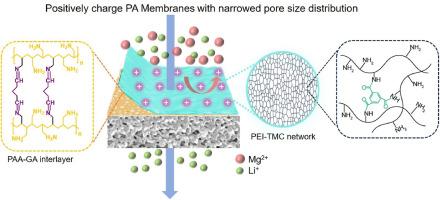Narrowed pore size distribution of positively charged nanofiltration membranes via interlayer-tailored interfacial polymerization for lithium extraction
IF 9
1区 工程技术
Q1 ENGINEERING, CHEMICAL
引用次数: 0
Abstract
Positively charged polyamide (PA) nanofiltration (NF) membranes fabricated via interfacial polymerization of polyethyleneimine (PEI) and trimesoyl chloride (TMC) hold great potential for lithium extraction from salt-lake brines, but still face challenges in precise Li+/Mg2+ separation under high-salinity conditions due to broad pore size distribution and electrostatic shielding. Herein, we designed a PEI/TMC-based PA membrane with enhanced positive charge and narrowed pore size distribution. These properties were regulated by an interlayer fabricated via a Schiff base reaction between polyallylamine (PAA) and glutaraldehyde (GA) on a polysulfone (PSf) substrate. The enrichment and diffusion of amine monomers were regulated by the interlayer, as confirmed through experiments and molecular dynamics simulations. As a result, a PA layer with narrowed pore size distribution (σp reduced from 1.36 to 1.21), increased positive surface charge, and reduced thickness was obtained. The optimized interlayer polyamide (iPA) membrane demonstrated a remarkable Li+/Mg2+ separation factor up to 174.1 in simulated brine, a two-fold increase in water permeance of 5.5 L m−2 h−1 bar−1, as well as excellent long-term separation stability under high-salinity conditions. This work highlights the potential of iPA membranes for achieving both high lithium purity and recovery, offering a promising avenue for lithium extraction from high-concentration salt-lake brines.

层间定制界面聚合窄化带正电纳滤膜孔径分布的锂萃取研究
聚乙烯亚胺(PEI)和三聚氯胺(TMC)界面聚合制备的正电荷聚酰胺(PA)纳滤(NF)膜在盐湖盐水中提取锂具有很大的潜力,但由于宽孔径分布和静电屏蔽,在高盐度条件下精确分离Li+/Mg2+仍面临挑战。在此,我们设计了一种具有增强正电荷和缩小孔径分布的PEI/ tmc基PA膜。这些性能是由聚砜(PSf)底物上聚烯丙胺(PAA)和戊二醛(GA)之间的席夫碱反应制备的中间层调节的。通过实验和分子动力学模拟证实了中间层对胺类单体富集和扩散的调控作用。结果表明,制备的PA层孔径分布变窄(σp由1.36减小到1.21),表面正电荷增加,厚度减小。优化后的层间聚酰胺(iPA)膜在模拟盐水中的Li+/Mg2+分离系数高达174.1,渗透率提高了两倍,达到5.5 L m−2 h−1 bar−1,并且在高盐度条件下具有良好的长期分离稳定性。这项工作强调了iPA膜在实现高锂纯度和回收率方面的潜力,为从高浓度盐湖盐水中提取锂提供了一条有前途的途径。
本文章由计算机程序翻译,如有差异,请以英文原文为准。
求助全文
约1分钟内获得全文
求助全文
来源期刊

Journal of Membrane Science
工程技术-高分子科学
CiteScore
17.10
自引率
17.90%
发文量
1031
审稿时长
2.5 months
期刊介绍:
The Journal of Membrane Science is a publication that focuses on membrane systems and is aimed at academic and industrial chemists, chemical engineers, materials scientists, and membranologists. It publishes original research and reviews on various aspects of membrane transport, membrane formation/structure, fouling, module/process design, and processes/applications. The journal primarily focuses on the structure, function, and performance of non-biological membranes but also includes papers that relate to biological membranes. The Journal of Membrane Science publishes Full Text Papers, State-of-the-Art Reviews, Letters to the Editor, and Perspectives.
 求助内容:
求助内容: 应助结果提醒方式:
应助结果提醒方式:


